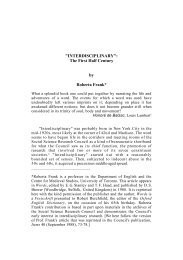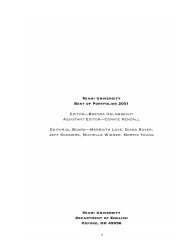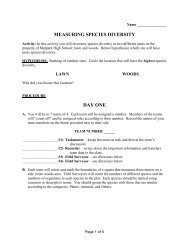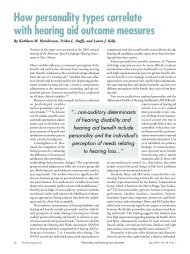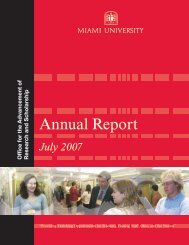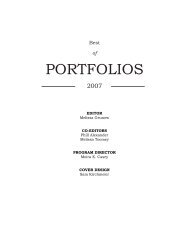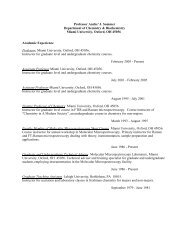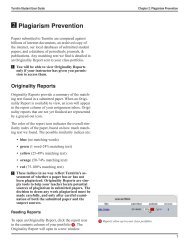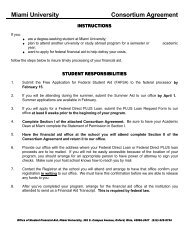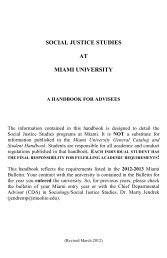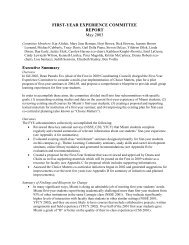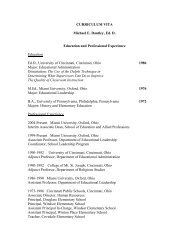Interdisciplinary Research Manual - Units.muohio.edu
Interdisciplinary Research Manual - Units.muohio.edu
Interdisciplinary Research Manual - Units.muohio.edu
Create successful ePaper yourself
Turn your PDF publications into a flip-book with our unique Google optimized e-Paper software.
15<br />
In interdisciplinary studies, on the other hand, the whole point is to draw on<br />
different perspectives and integrate their insights, so an early order of business in<br />
evaluating a book is to identify its perspective. You need to determine where the author is<br />
coming from— what perspective the book represents.<br />
To find out, you need to hunt around. If you are lucky, the authors or editors may<br />
set out in the introduction their perspective on the topic—e.g., my work comes out of the<br />
study of American politics, I’m a professor of political science at Harvard University, and<br />
I teach courses in American politics. More often, though, they introduce only the topic<br />
itself and you are left to try to infer their perspective from what they say about the topic.<br />
With experience, once in a while you can tell something about the perspective from the<br />
publisher—Monthly Review Press publishes Marxists, Transactions Books publishes left<br />
wing sociology, etc.—though more often the publisher is a clue instead to the quality of<br />
the book, with university presses at the top. A foreword (typically written by someone<br />
other than the author) might discuss the author’s perspective, but even that may focus less<br />
on the perspective and more on the significance of the book. Overall, these strategies are<br />
not promising. So where do you go to find the perspective from which the book was<br />
written?<br />
If the book provides it, the quickest and easiest source of information on<br />
perspective is the author’s bio—a biographical sketch that includes institutional<br />
affiliation and position, and selected publications by the author. Look on the back of the<br />
dust jacket (normally removed by libraries) or the back cover of a paperback book or a<br />
glossy hardcover book. You may also find it near the beginning or end of the book.<br />
While it’s worth a quick look to find it, too often it’s simply not provided. The preface is<br />
another reasonable place to look, since it typically explains how the author came to write<br />
the book, but you can’t count on finding it there either. When all else fails, go to Google<br />
and type in the author’s name (in quotation marks), scan down for something that’s likely<br />
to give at least the person’s institutional affiliation and job title. If you assess books with<br />
the computer sitting next to you, it doesn’t take long to find this much information (and<br />
you can enter the full bibliographical information on the book for your annotated<br />
bibliography).<br />
One might naively think that since academic scholars enjoy academic freedom,<br />
they are not fettered by their job title, location within the institution, or the institution<br />
with which they are affiliated. But one’s department makes decisions about one’s<br />
promotion, tenure, and annual salary adjustment; one’s institution pays that salary and<br />
makes decisions about sabbaticals; and one’s discipline determines whether one gets to<br />
present papers at which conferences, whether one gets those papers published in journals,<br />
whether one is invited to contribute to edited volumes or to give talks at departmentallysponsored<br />
lecture series, and whether one is awarded research grants. Control of the<br />
perquisites does not determine what conclusions one must arrive at in one’s publications,<br />
but they do constrain one’s approach—in short, they enforce one’s adherence to the<br />
perspective of the discipline.<br />
The bibliography (a.k.a. references or works cited) is the most consistent source<br />
of information on the author’s perspective. Scan down the list, ask yourself what<br />
disciplines (art history), schools of thought (Marxist), or interdisciplines (women’s<br />
studies) are represented by these titles, and mentally tote up how many are showing up in<br />
each category. Let’s say you find something like 40 books from American politics, 25



